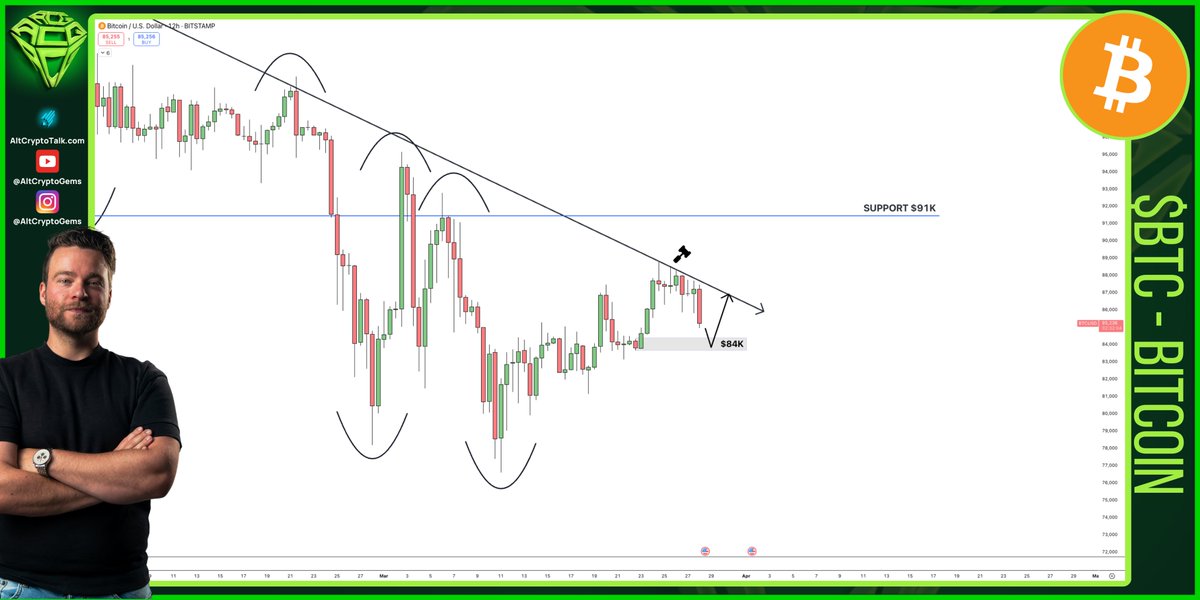The Current Landscape
Imagine standing at the edge of a cliff, looking down at the tumultuous waves of the crypto market. Today, Bitcoin finds itself at a similar precipice. The world’s leading cryptocurrency has once again been rejected at a critical resistance level, confirming a local downtrend. As of March 28, 2025, the bulls are needed to defend the $84,000 mark to preserve the 4-hour bullish market structure. But what does this mean for investors, and what can we expect in the coming weeks? Let’s delve into the technicals and broader market dynamics to understand the potential scenarios.
Understanding the Technicals
The Diagonal Resistance
To grasp the current situation, let’s dive into the technicals. Bitcoin has been facing a diagonal resistance line, a trendline that connects a series of lower highs. This line has proven to be a formidable barrier, with the price bouncing back down each time it approaches. This pattern is a classic example of a descending trend channel, indicating a bearish sentiment in the short term.
In technical analysis, a diagonal resistance line is often seen as a psychological barrier for traders. When the price approaches this line, sellers tend to become more active, pushing the price back down. This creates a self-reinforcing cycle where the resistance line becomes increasingly difficult to break through. For Bitcoin, the diagonal resistance line has been a significant obstacle, and breaking through it would require a substantial shift in market sentiment.
The $84,000 Support Level
The $84,000 mark is a crucial support level for Bitcoin. If the price falls below this point, it could signal a further decline, potentially leading to a more significant downtrend. The bulls, therefore, need to step in and defend this level to maintain the current 4-hour bullish market structure. But what if they fail? Understanding the implications of a breakdown below this support level is essential for investors to make informed decisions.
The Bearish Scenario
If the bears manage to break down the $84,000 support, we could see a steep decline. The next significant support level is around $70,000, but if the selling pressure continues, the price could drop even further. This scenario would be a nightmare for bullish investors, but it’s essential to consider all possibilities. A breakdown below $84,000 could trigger a cascade of sell orders, leading to a rapid decline in price.
In such a scenario, investors should be prepared for increased volatility and potential market panic. Historical data shows that sharp declines in Bitcoin’s price often lead to a wave of selling, as investors rush to exit their positions. However, it’s important to note that such declines can also present buying opportunities for those with a long-term perspective.
The Bullish Counterattack
However, the story doesn’t end there. The market is a battlefield of bulls and bears, and the bulls are not going down without a fight. If they can successfully defend the $84,000 level, we could see a reversal. The price might break through the diagonal resistance, leading to a bullish trend. But for this to happen, the bulls need to show up in force.
A bullish counterattack would require a significant influx of buying pressure. This could be driven by positive news, such as regulatory developments or institutional adoption. For example, if a major financial institution announces plans to invest in Bitcoin, it could boost market sentiment and drive the price higher. Similarly, positive geopolitical events could also fuel a bullish rally.
The Broader Picture
While the short-term outlook is uncertain, it’s crucial to consider the broader picture. Bitcoin has a history of volatility, with sharp declines often followed by impressive recoveries. Moreover, the cryptocurrency market is influenced by a multitude of factors, including geopolitical events, regulatory changes, and technological advancements. Therefore, while the technicals provide valuable insights, they are not the be-all and end-all.
Bitcoin’s price movements are often driven by a combination of technical and fundamental factors. For instance, technological advancements, such as the implementation of the Lightning Network, can enhance Bitcoin’s scalability and usability, potentially driving demand higher. Similarly, regulatory changes can impact market sentiment and price movements. Therefore, investors should keep an eye on both technical indicators and broader market trends.
The Role of Market Sentiment
Market sentiment plays a significant role in Bitcoin’s price movements. Fear, greed, and uncertainty can drive the price up or down, often in ways that defy logical explanation. Therefore, it’s essential to keep an eye on market sentiment indicators, such as the Fear & Greed Index, to gauge the overall mood of the market.
The Fear & Greed Index is a popular tool used by traders to measure market sentiment. It ranges from 0 to 100, with 0 indicating extreme fear and 100 indicating extreme greed. When the index is low, it often signals a buying opportunity, as prices are likely to rebound. Conversely, when the index is high, it may indicate that the market is overbought, and a correction could be on the horizon.
The Impact of External Factors
External factors, such as regulatory changes and geopolitical events, can also significantly impact Bitcoin’s price. For instance, positive regulatory developments can boost investor confidence, leading to a price rally. Conversely, negative news can trigger a sell-off, causing the price to plummet. Therefore, it’s crucial to stay informed about the latest developments in the crypto world and beyond.
Regulatory changes can have a profound impact on Bitcoin’s price. For example, if a major economy announces plans to adopt Bitcoin as legal tender, it could drive demand higher and boost the price. Similarly, negative regulatory developments, such as bans or restrictions, can lead to a sell-off. Therefore, investors should stay informed about regulatory changes and their potential impact on the market.
Conclusion: The Road Ahead
As we stand at the crossroads of March 2025, the future of Bitcoin hangs in the balance. The bulls and bears are locked in a fierce battle, with the outcome uncertain. But one thing is clear: the crypto market is a rollercoaster ride, filled with twists, turns, and unexpected surprises. So, buckle up and hold on tight, because the journey is far from over.
Investors should remain vigilant and prepared for both bullish and bearish scenarios. While technical analysis provides valuable insights, it’s essential to consider the broader market dynamics and external factors. By staying informed and adaptable, investors can navigate the volatile crypto market and capitalize on opportunities as they arise. The road ahead is uncertain, but with the right mindset and strategy, investors can weather the storm and emerge stronger.
References
For further reading and a deeper dive into the technical analysis, you can refer to the following sources:





